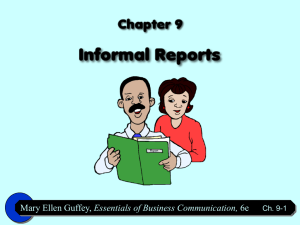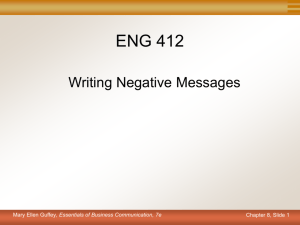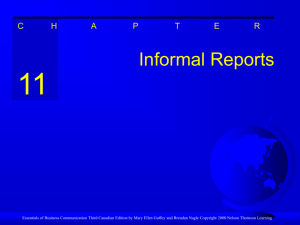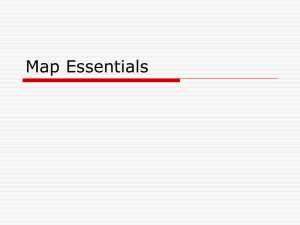DIT Chapter 01 BCom
advertisement
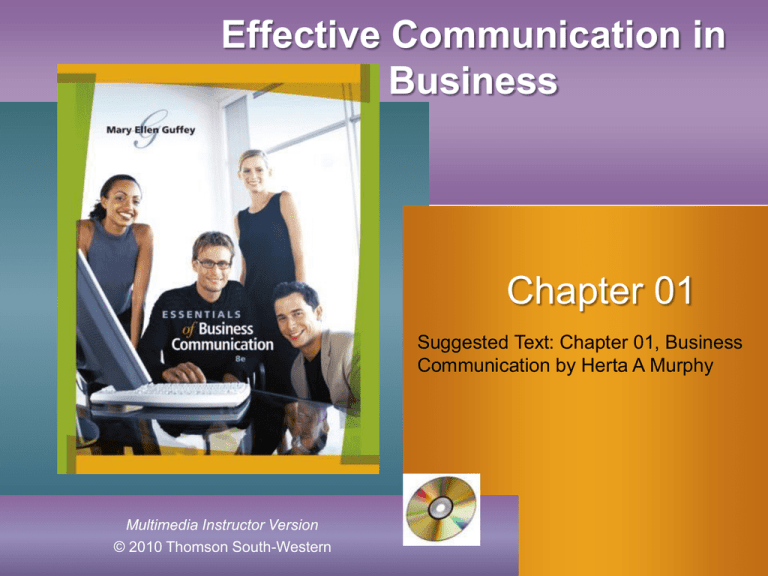
Effective Communication in Business Chapter 01 Suggested Text: Chapter 01, Business Communication by Herta A Murphy Multimedia Instructor Version © 2010 Thomson South-Western Why effective Communication If you can communicate effectively in speaking and writing, you have a highly valued skill. Effective communication is a basic job requirement and first among the personal factors necessary for promotion. Mary Ellen Guffey, Essentials of Business Communication, 8e Chapter 3, Slide 2 Defining Communication Communication is the exchange of information between humans who are aware of each others. This information is transmitted – interpreted received on a conscious as well as a subconscious level. OR Communication is the process of recieving verbal and non verbal messages. Mary Ellen Guffey, Essentials of Business Communication, 8e Chapter 3, Slide 3 Components of Communication Communication is considered effective when it achieves the desired response from the receiver. Simply speaking communication is a two way process of exchanging information. To understand the two way process we need to understand the components or parts of communication. Mary Ellen Guffey, Essentials of Business Communication, 8e Chapter 3, Slide 4 The six components of effective communication 1. Context 2. Sender-Encoder 3. Message 4. Medium 5. Receiver-Decoder 6. Feedback It is also called the communication process. Mary Ellen Guffey, Essentials of Business Communication, 8e Chapter 3, Slide 5 The communication process Mary Ellen Guffey, Essentials of Business Communication, 8e Chapter 3, Slide 6 1. Context Every message weather oral or written begins with the context. Context means the background or the situation in which you communicate. The context may be as a result of some external stimuli that makes you to send a message, for example a letter, email, fax or telephone call etc. The context may be as a result of some idea or feeling. Mary Ellen Guffey, Essentials of Business Communication, 8e Chapter 3, Slide 7 2. Sender-Encoder When you send a message you are the encoder. Encoder means writer or speaker, depending on whether your message is written or oral. You choose a combination of words that the reader shall understand and respond in a way that you need. For effective communication you should decide an effective channel for communication the message, both written and oral. Mary Ellen Guffey, Essentials of Business Communication, 8e Chapter 3, Slide 8 3. Message Message is the core idea that you wish to communicate. It consists of both verbal (written and spoken) and non verbal (un spoken) symbols. First of all you have to decide what your message is and what should you include in that. The receiver of the message must be considered while writing your message, specially his or her level of understanding. Mary Ellen Guffey, Essentials of Business Communication, 8e Chapter 3, Slide 9 4. Medium ‘Should you write or speak’ to communicate your message? Selecting a method to communicate your message, like email, printed or oral is called the medium. Language used is also a part of medium. Mary Ellen Guffey, Essentials of Business Communication, 8e Chapter 3, Slide 10 5. Receiver-Decoder The message receiver is your reader or listener, also called decoder. Many of your messages may have more than one decoder. Receiver receives messages through the eyes and ears but are also by their mental filters. So there may be chances of miscommunication but effective managers tend to keep it at minimum. Mary Ellen Guffey, Essentials of Business Communication, 8e Chapter 3, Slide 11 6. Feedback The reaction or response of receiver, either the desired response, based on a clear understanding of the message, or with an undesired response, based on miscommunication. It may also be an action for example receiving the items that you ordered. Sometimes silence is used as feedback. Sender needs feedback in order to confirm the success or failure of the communication. Mary Ellen Guffey, Essentials of Business Communication, 8e Chapter 3, Slide 12 Types of Communication There are two main types of communication. 1. Verbal Communication 2. Non Verbal Communication Mary Ellen Guffey, Essentials of Business Communication, 8e Chapter 3, Slide 13 Verbal Communication: Communication that involves words, like written or spoken. Non Verbal Communication: The process of sending and receiving wordless messages like, gestures, facial expressions, body language, eye contact, symbols, dress etc. Mary Ellen Guffey, Essentials of Business Communication, 8e Chapter 3, Slide 14 Communication process applies to both verbal and non verbal communication. Mary Ellen Guffey, Essentials of Business Communication, 8e Chapter 3, Slide 15 NON-VERBAL COMMUNICATION HOW WE STAND FACIAL EXPRESSIONS KINESIS POSTURE LAUGHING USE OF LEGS USE OF ARMS Mary Ellen Guffey, Essentials of Business Communication, 8e Chapter 3, Slide 16 Common Problem Areas The following are supposed to be the common problem areas. 1. Sending: 2. Environment: 3. Receiving: 17 Mary Ellen Guffey, Essentials of Business Communication, 8e Chapter 3, Slide 17 Problems in Sending using technical words for communication to nontechnical people forgetting that the visual and vocal elements are the most important, words less. Ignoring the situation, expectencies and interests of the listener according to their expertise. 18 Mary Ellen Guffey, Essentials of Business Communication, 8e Chapter 3, Slide 18 Noise in the environment Noise creates distortions of the message and prevents it from being understood the way it is intended Noises may be ringing telephones, honking horns etc. Time, inapropriate time may be an obstacle to give message clearly.Thursday afternoon is not proper for a heavy meeting. 19 Mary Ellen Guffey, Essentials of Business Communication, 8e Chapter 3, Slide 19 Receiver Problems Poor listen ability Lack of attention Emotional state, stress, fear, anger Prejudgements Be sure that the receiver is attentive 20 Mary Ellen Guffey, Essentials of Business Communication, 8e Chapter 3, Slide 20 DIRECTION OF COMMUNICATION DOWNWARD HORIZONTAL Mary Ellen Guffey, Essentials of Business Communication, 8e UPWARD DIAGIONAL Chapter 3, Slide 21 Downward Communication Downward communication flows from top to bottom or from higher positions to the lower. For example manager to assistant manager, assistant manager to supervisor, supervisor to clerk etc. Mary Ellen Guffey, Essentials of Business Communication, 8e Chapter 3, Slide 22 UPWARD COMMUNICATION SUPERINTENDENTS ASSISTANT SUPERINTENDENTS PRINCIPALS ASSISTANT PRINCIPALS FACULTY Mary Ellen Guffey, Essentials of Business Communication, 8e Chapter 3, Slide 23 HORIZONTAL COMMUNICATION ASSISTANT PRINCIPAL ASSISTANT PRINCIPAL FACULTY MEMBER OFTEN OVERLOOKED AS UNIMPORTANT FACILITATE COORDINATION BETWEEN UNITS FACULTY MEMBER FURNISHES ACHIEVED EMOTIONAL THROUGH SUPPORT CROSS-FUNCTIONAL AMONG PEERS COMMITTEES Mary Ellen Guffey, Essentials of Business Communication, 8e Chapter 3, Slide 24 DIAGIONAL COMMUNICATION SUPERINTENDENT ASSIST. SUPT. FOR PERSONNEL DIRECTOR OF PERSONNEL CHIEF NEGOTIATOR ASST. SUPT. FOR INSTRUCTION ELEM. ED. COORDINATOR ELEMENTARY PRINCIPAL SECONDARY ED. COORDINATOR ASST. SUPT.FOR BUSINESS ACCOUNTANTS SECONDARY PRINCIPAL Mary Ellen Guffey, Essentials of Business Communication, 8e Chapter 3, Slide 25 Why do we communicate? Mary Ellen Guffey, Essentials of Business Communication, 8e Chapter 3, Slide 26 Why do we communicate? Generally there are three reasons for communication 1. Biological needs 2. Interpersonal needs 3. Social needs Mary Ellen Guffey, Essentials of Business Communication, 8e Chapter 3, Slide 27 • Biologic needs Food, shelter, cloth … Mary Ellen Guffey, Essentials of Business Communication, 8e Chapter 3, Slide 28 Interpersonal needs Forwarding office files to others Writing an application for leave Forwarding phone calls Mary Ellen Guffey, Essentials of Business Communication, 8e Chapter 3, Slide 29 Social needs Party invitations Sadness and joys Prayers Reference groups Mary Ellen Guffey, Essentials of Business Communication, 8e Chapter 3, Slide 30


